Reading in English as a Foreign language: Examining differences in reading speed, comprehension, efficacy and L1 cross-linguistic influence across grades
DOI:
https://doi.org/10.24310/revistaisl.vi9.11099Resumen
Reading in a second or foreign language (L2) is a more complicated process than reading in one's first language because it requires additional demands on the reader. Reading can be assessed from various domains. Reading fluency is known to be the most determining domain to identify reading problems (Rasinski, 2000). However, the goal of reading is comprehending a text, so comprehension should not be disregarded either. Despite the importance of reading in an L2, few studies have focused on examining its effects. The goal of the present study is threefold: first, to provide the estimates of L2 English reading rates of L1 Catalan/Spanish students of different ages and grades; second, to examine whether there are significant differences between participants of different grades in terms of reading rates, comprehension and efficacy; and third, to explore whether the students' reading rates in the L1 are correlated with their L2 reading rates and if so, the extent to which L1 reading rates explain L2 reading rates.
790 Catalan/Spanish learners of English participated in the present study. Participants were from 5th grade primary (age 12) to 2nd baccalaureate (age 18). They were asked to read two texts, one in English and the other one in their L1 (they could choose between Catalan or Spanish). They were asked to answer 7 multiple-choice comprehension questions after reading each text. Next, their scores on fluency (words read per minute), comprehension (percentage of comprehended text) and efficacy (a formula that integrates speed and comprehension) were obtained. Results show that reading fluency and comprehension are not linear and that they do not necessarily improve over time. Results also show that L1 and L2 reading fluency rates are highly correlated and that L1 reading rates explain a large percentage of L2 reading rates.
Descargas
Métricas
Publicación Facts
Perfil de revisores N/D
Información adicional autores
Indexado: {$indexList}
-
Indexado en
- Sociedad Académica/Grupo
- N/D
- Editora:
- EduVerso, Universidad de Málaga
Descargas
Publicado
Cómo citar
Número
Sección
Licencia
Todos los contenidos publicados en Investigaciones sobre la Lectura están sujetos a la licencia Creative Commons Reconocimento-NoComercia-Compartirigual 4.0 cuyo texto completo puede consultar en <http://creativecommons.org/licenses/by-nc-sa/4.0>
Se pueden copiar, usar, difundir, transmitir y exponer públicamente, siempre que:
- Se cite la autoría y la fuente original de su publicación (revista, editorial y URL de la obra).
- No se usen para fines comerciales.
- Se mencione la existencia y especificaciones de esta licencia de uso.
Los derechos de autor son de dos clases: morales y patrimoniales. Los derechos morales son prerrogativas perpetuas, irrenunciables, intransferibles, inalienables, inembargables e imprescriptibles. De acuerdo con la legislación de derechos de autor, Investigaciones sobre la Lectura reconoce y respeta el derecho moral de los/las autores/as, así como la titularidad del derecho patrimonial, el cual será cedido a la Universidad de Málaga para su difusión en acceso abierto. Los derechos patrimoniales, se refieren a los beneficios que se obtienen por el uso o divulgación de las obras. Investigaciones sobre la Lectura se publica en open access y queda autorizada en exclusiva para realizar u autorizar por cualquier medio el uso, distribución, divulgación, reproducción, adaptación, traducción o transformación de la obra.
Es responsabilidad de los/las autores/as obtener los permisos necesarios de las imágenes que están sujetas a derechos de autor.


























30.png)




